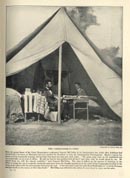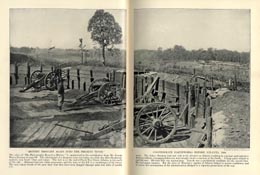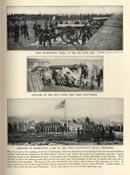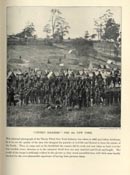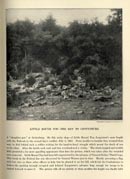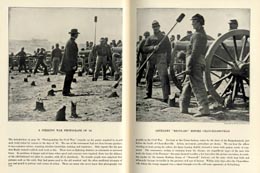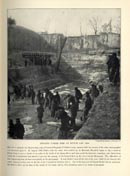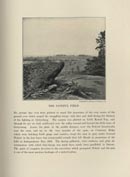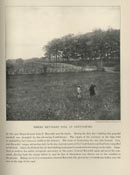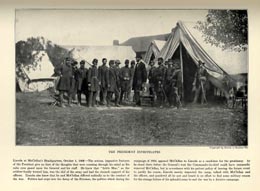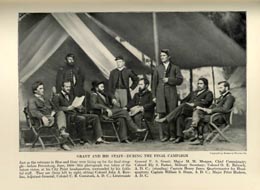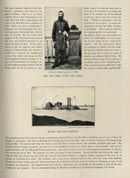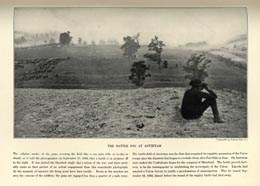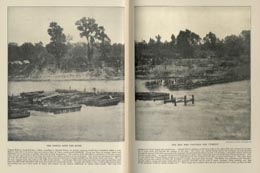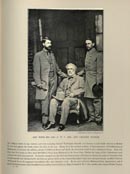THE PHOTOGRAPHIC RECORD
AS HISTORY
[Back to
Civil War Pictures]
By
GEORGE HAVEN PUTNAM
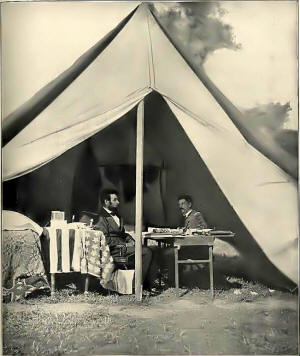 To
one examining the unique series of photographs which were secured,
during the campaigns of our great Civil War, by the pluck and
persistence of
Brady and Gardner, and the negatives of which have, almost
miraculously, been preserved through the vicissitudes of time,
comes, however, the feeling that these battles and marchings were the
events not of one hundred and fifty years back, but of yesterday, if not, indeed, things
of today. These vivid pictures bring past history into the present
tense; the observer sees our citizen soldiers as they camped, as they
marched, and as they fought, and comes to know how they lived and how
they died. There are revealed to the eye through these lifelike
photographs, as if through a vitascope, the successive scenes of the
great life-and-death drama of the nation's struggle for existence, a
struggle which was fought out through four eventful years, and in which
were sacrificed of the best of manhood of the country, North and South,
eight hundred thousand lives. To
one examining the unique series of photographs which were secured,
during the campaigns of our great Civil War, by the pluck and
persistence of
Brady and Gardner, and the negatives of which have, almost
miraculously, been preserved through the vicissitudes of time,
comes, however, the feeling that these battles and marchings were the
events not of one hundred and fifty years back, but of yesterday, if not, indeed, things
of today. These vivid pictures bring past history into the present
tense; the observer sees our citizen soldiers as they camped, as they
marched, and as they fought, and comes to know how they lived and how
they died. There are revealed to the eye through these lifelike
photographs, as if through a vitascope, the successive scenes of the
great life-and-death drama of the nation's struggle for existence, a
struggle which was fought out through four eventful years, and in which
were sacrificed of the best of manhood of the country, North and South,
eight hundred thousand lives.
Recollections of a Civil War Soldier
In
September, 1862, I landed in New York from the Bremen steamer Hansa,
which was then making its first trans-atlantic trip. I had left my
German university for the purpose of enlisting in the Union army, and,
with the belief that the war could hardly be prolonged for many further
months, I had secured leave of absence from my university only for the
college year. I have today a vivid recollection of the impression made
upon the young student by the war atmosphere in which he found his home
city. In coming up from the steamship pier, I found myself on
Broadway
near the office of the Herald, at that time at the corner of Ann Street.
The bulletin board was surrounded by a crowd of anxious citizens, whose
excitement was so tense that it expressed itself not in utterance but in
silence. With some difficulty, I made my way near enough to the building
to get a glimpse of the announcement on the board. The heading was, "A
battle is now going on in Maryland; it is hoped that General McClellan
will drive Lee's army back into the Potomac."
I
recall today the curious impressiveness of the present tense, of the
report of a battle that was actually "going on." To one who reads such
an announcement, all things seem to be possible, and as I stood
surrounded by men whose pulses were throbbing with the keenest of
emotions, I felt with them as if we could almost hear the sound of the
cannon on the Potomac. The contrast was the stronger to one coming from
the quiet lecture-rooms of a distant university to the streets of a
great city excited with twelve months of war, and with the ever-present
doubt as to what the hours of each day might bring forth. The fight that
was then "going on" is known in history as the battle of Antietam.
History tells us that Lee's army was not pushed into the Potomac. There
were two causes that prevented this resultóGeorge B. McClellan and
Robert E. Lee. McClellan was a skilled engineer and he knew how to
organize troops, but he never pushed an enemy's army before him with the
energy of a man who meant to win and who had faith that he could win. It
was his habit to feel that he had made a brilliant success when, having
come into touch with the foe, he had succeeded in withdrawing his own
army without undue loss; and it is fair to say that when the enemy was
Robert E. Lee, such a successful withdrawal might almost be considered
as a triumph.
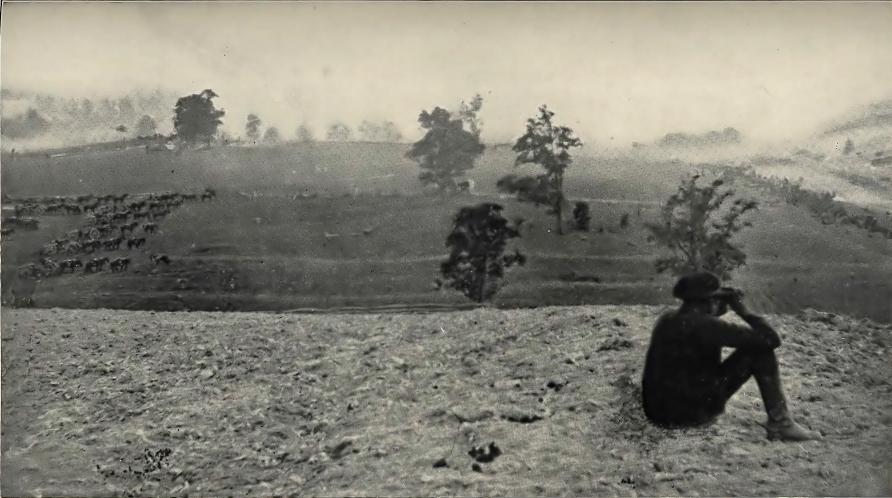
A fresh
and vivid impression of the scene of the bloody struggle at Antietam
Creek is given in one of the photographs in this great war series. The
plucky photographer has succeeded in securing, from the very edge of the
battlefield, a view of the movements of the troops that are on the
charge; and when, on the further edge of the fields, we actually see
the smoke of the long lines of rifles by which that charge is to be
repulsed, we feel as if the battle were again "going on" before our
eyes, and we find ourselves again infused with mingled dread and
expectation as to the result.
In
looking at the photographs, the Union veteran recalls the fierce charge
of Burnside's men for the possession of the
bridge and the sturdy
resistance made by the regiments of Longstreet. He will grieve with the
Army of the Potomac and with the country at the untimely death of the
old hero, General Mansfield; he will recall the graphic description
given by the poet Holmes of the weary week's search through the
battlefield and the environs for the "body" of his son, the young
captain, who lived to become one of the scholarly members of the
national Supreme Court; and he may share the disappointment not only of
the army, but of the citizens back of the army, that, notwithstanding
his advantages of position, McClellan should have permitted the
Confederate army to withdraw without molestation, carrying with it its
trains, its artillery, and even its captured prisoners.
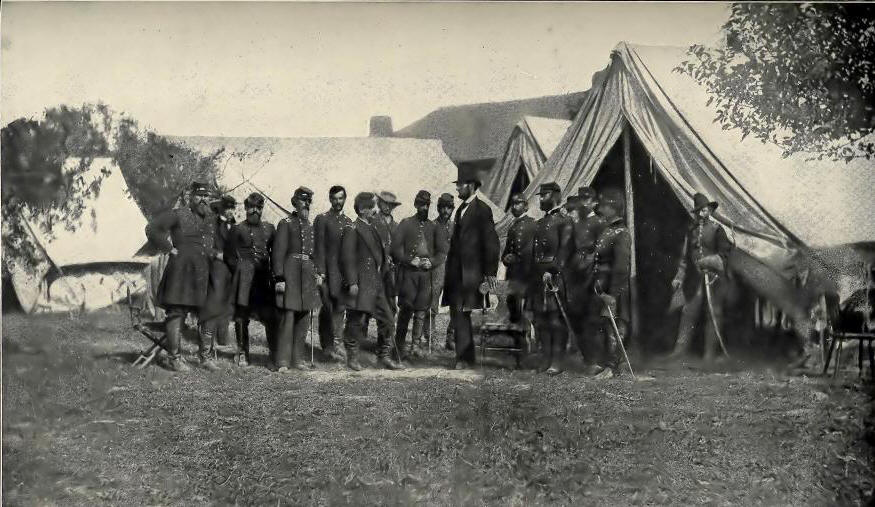
Another
photograph in the series, which is an example of special enterprise on
the part of Mr. Brady, presents Lincoln and McClellan in consultation
some time after this bloody and indecisive battle. The pose and the
features of the two men are admirably characteristic. Two weeks have
elapsed since Lee's withdrawal across the river, but the Army of the
Potomac, while rested and fully resupplied, has been held by its young
commander in an inexplicable inaction. Lincoln's persistent demand for
an advance and his reiterated inquiries as to the grounds for the delay
have met with no response. The President finally comes to the camp for a
personal word with the commander in the field. How the photographer
secured the opportunity of being present at such an interview one does
not know, but that he was there is unmistakable.
These
vivid photographs which constitute the great historic series bring again
into the present tense, for the memories of the veterans, all of the
dramatic scenes of the years of war; and even to those who are not
veterans, those who have grown up in years of peace and to whom the
campaigns are but historic pages or dim stories,
even to them must come, in looking at these pictures of campaigns, these
vivid episodes of life and death, a clearer realization than could be
secured in any other way of what the four years' struggle meant for
their ancestors.
The
fine views of Fort Stevens and Fort Lincoln recall the several periods
in which, to the continuing anxieties of the people's leader, was added
immediate apprehension as to the safety of the national capital. On the
19th of April, 1861, the Massachusetts Sixth, on its way to the
protection of Washington, had been
attacked in Baltimore, and
connections between Washington and the North were cut off. A few
hundred troops represented all the forces that the nation had for the
moment been able to place in position for the protection of the capital.
I have stood, as thousands of visitors have stood, in Lincoln's old
study, the windows of which overlook the Potomac; and I have had
recalled to mind the vision of his tall figure and sad face as he stood
looking across the river where the picket lines of the Virginia troops
could be traced by the smoke, and dreading from morning to morning the
approach of these troops over the
Long Bridge. There must have come to
Lincoln during these anxious days the dread that he was to be the last
President of the United States, and that the torch, representing the
life of the nation, that had been transmitted to him by the faltering
hands of his predecessor was to expire while he was still responsible
for the continuity of the flame.
And it was not only in 1861 that the
capital was imperiled. The anxiety of the President (never for himself,
but only for his country and his responsibilities) was to be renewed in
June, 1863, when Lee was in Maryland, and in July, 1864, at the time of
Early's raid. It was during Early's hurried attack that Lincoln,
visiting Fort Stevens, came into direct sight of the fighting by which
Early's men were finally repulsed. For the President, the war must
indeed at this time have been something in the present tense, something
which meant dreaded possibilities always impending.
The month of July, 1863, marked the
turning point of the great contest. If the Federal lines had been broken
at Gettysburg, Lee would have been able, in placing his army across the
highways to Baltimore and to Philadelphia, to isolate Washington from
the North. The Army of the Potomac would, of course, have been
reconstituted, and Lee would finally have been driven across the Potomac
as he was actually compelled to retire after the decision of the battle.
But such a check to the efforts of the North, after two years of war for
the maintenance of the nation, would in all probability have secured
success for the efforts of the Confederate sympathizers in Europe and
have brought about recognition and intervention on the part of France
and of England. Such an intervention would have meant the triumph of the
Confederacy and the breaking up of the great Republic. The value for the
cause of the success of Meade in repelling, with heavy loss, the final
assaults of Lee was further emphasized by a great triumph in the West.
On the very day on which Lee's discomfited army was making its way back
to the Potomac, the troops of
General Grant were placing the
Stars and
Stripes over the well-defended works of Vicksburg.
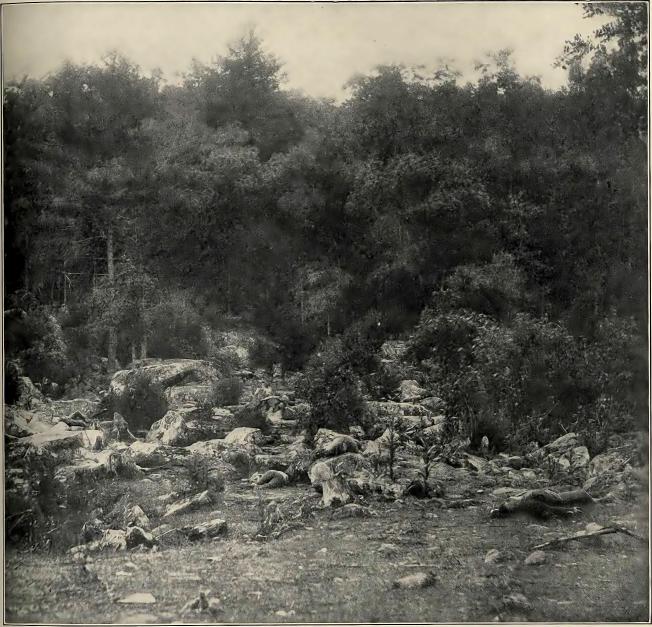
A beautiful little picture recalls the
sharp fight that was made, on July 2, 1863, for the possession of Little
Round Top. It was the foresight of General Warren that recognized the
essential importance of this position for the maintenance of the Union
line. After the repulse of Sickles's Third Corps in the Peach Orchard,
Longstreet's men were actually on their way to take possession of the
rocky hill from which the left and rear of the Union line could have
been enfiladed. No Union force was for the moment available for the
defense, but Warren, with two or three aides, raised some flags over the
rocks, and the leader of Longstreet's advance, getting an impression
that the position was occupied, delayed a brief spell for reinforcements.
This momentary respite gave Warren time
to bring to the defense of the hill troops from the nearest command that
was available, a division of the Fifth Corps. A few minutes later, came
the first attack, followed by a series of fierce onsets that continued
through the long summer afternoon. With some advantages of position, and
with the realization that the control of the hill was absolutely
essential for the maintenance of the line, the Federals held their own;
but when darkness fell, the rocks of Devil's Den and the slopes of the
hill were thickly strewn with dead, the bodies of the Blue and the Gray
lying closely intermingled. A beautiful statue of Warren now stands on
Little Round Top at the point where, almost single-handed, he placed his
flag when there were no guns behind it. The general is looking out
gravely over the slope and toward the opposite crest, where have been
placed, in grim contrast to the smiling fields of the quiet farm behind,
the Confederate field-guns that mark the position of Longstreet's
lines.
The First Ironclads
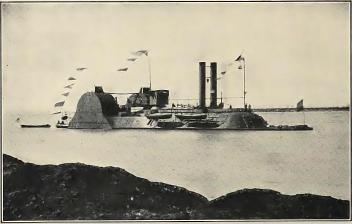 The editors have fortunately been able to
include with the great Brady series of army photographs a private
collection, probably unique, of more than four hundred views of the
gunboats on the rivers of the West. Each of these vessels represents a
history of its own. One wishes for the imagination of a Homer which
could present with due effectiveness a new "catalogue of the ships." The editors have fortunately been able to
include with the great Brady series of army photographs a private
collection, probably unique, of more than four hundred views of the
gunboats on the rivers of the West. Each of these vessels represents a
history of its own. One wishes for the imagination of a Homer which
could present with due effectiveness a new "catalogue of the ships."
Admiral Farragut, while accepting the
armored vessels as possessing certain advantages and as apparently a
necessity of "modern warfare," had the impatience of the old-fashioned
sailor against any such attempt at protection. He preferred for himself
the old type of wooden frigate of which his flag-ship, the famous
Hartford, was the representative. "Why," said he, "if a shell strikes
the side of the Hartford it goes clean through. Unless somebody happens
to be directly in the path, there is no damage, excepting a couple of
easily plugged holes. But when a shell makes its way into one of those
'damned tea-kettles,' it can't get out again. It sputters round inside
doing all kinds of mischief." It must be borne in mind, apart from the
natural exaggeration of such an utterance, that Farragut was speaking
in the time of slow-velocity missiles. His phrase "damned tea-kettles" came, however, to be the general descriptive term
for the ironclads, applied not only by the men in the ranks but by the
naval men themselves.
There were assured advantages given by
the armor in time of action against most of the fire that was possible
with the weapons of the day, but for the midsummer climate of Louisiana,
the tea-kettles "were most abominable abiding places. During the day,
the iron of the decks would get so hot that the hand could barely rest
upon it. At night, sleep was impossible. The decks were kept wetted
down, and the men lay on them, getting, toward the morning hours when
the hulls had cooled down, such sleep as could be secured.
The progress of the armored transports
making their way up the Red River under fire from the shore was an
interesting feature of that campaign. The steepness of the banks on the
Red River gave peculiar advantages for such fire, as it was frequently
the case that the guns of the boats could not be elevated so as to reach
the foe's position. It was difficult to protect the man at the wheel
from such plunging fire, but bales of cotton were often placed around
the upper works which were sufficient to keep off at least musketry
fire. This improvised armor proved, however, not only insufficient but a
peril when the enterprising Confederate gunners succeeded in discharging
from their field-pieces red-hot shot. It happened more than once (I
recall witnessing one such incident) that the cotton was brought into
flames by such shot and it became necessary to run the vessel ashore.
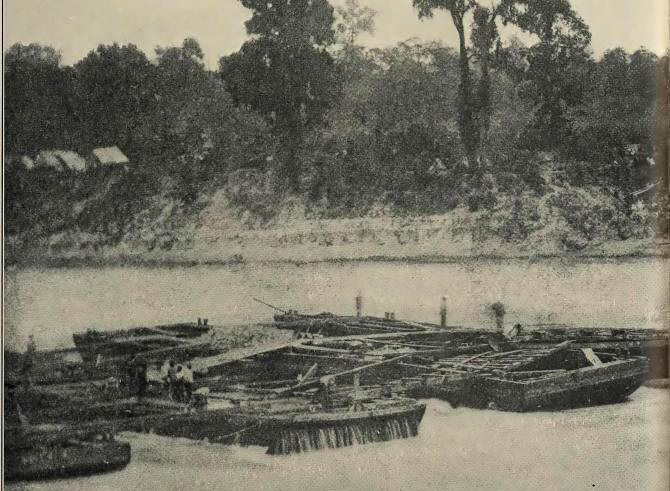
A photograph in the series which presents
a picturesque view of the famous Red River dam recalls some active
spring days in Louisiana. The photograph gives an excellently accurate
view of a portion of the dam, through the building of which Admiral
Porter's river fleet of eleven " turtles " was brought safely over the
rapids at Alexandria, and the army of General Banks, repulsed and
disappointed but by no means demoralized, was able to make its way back
to the Mississippi with a very much lessened opposition. Through a
sudden fall of the river, the "turtles" had been held above the rapids
at Alexandria. Without the aid of Porter's guns to protect the flank of
the army retreating along the river road, it would have been necessary
to overcome by frontal attacks a series of breastworks by which this
road was blocked.
The energetic Confederate leader, General
Taylor, had managed to cut off all connections with the Mississippi,
and, while we were feeding in the town of Alexandria the women and
children whose men folks were fighting us from outside, we had rations
sufficient for only about three weeks. The problem was, within the time
at our disposal and with the material available (in a country in which
there was no stone), to increase the depth of water on the rapids by
about twenty-two inches. The plan submitted by the clever engineer
officer, Lieut.-Colonel Bailey, of the Fourth Wisconsin, was eagerly
accepted by General Banks. Under Bailey's directions, five wing-dams
were constructed, of which the shortest pair, with the widest aperture
for the water, was up-stream, while the longest pair, with the narrowest
passage for the water, was placed at the point on the rapids where the
increased depth was required. The water was thrown, as it were, into a
funnel, and not only was the depth secured, but the rush downward helped
to carry the vessels in safety across the rocks of the rapids. As I look
at the photograph, I recall the fatiguing labor of "house-breaking,"
when the troops were put to work, in details on alternate days, in
pulling down the sugar-mills and in breaking up the iron-work and the
bricks.
On the further side of the river, a
territory claimed by the sharpshooters of our opponents, men selected
from the Western regiments, protected more or less by our skirmish
line, are applying their axes to the shaping of the logs for the crates
from which the dams were constructed. The wood-chopping is being done
under a scattered but active fire, but while hastened somewhat in speed,
it loses none of its precision.
I recall the tall form of the big
six-footer,
Colonel Bailey, leading the way into the water where the men
had to work in the swift current at the adjustment of the crates, and
calling out, "Come along, boys; it's only up to your waists."
As in duty bound, I marched after the
colonel into the river, calling upon my command to follow; but the water
which had not gone very much above the waist of the tall colonel, caught
the small adjutant somewhere above the nostrils, with the result that he
was taken down over the rapids. He came up, with no particular damage,
in the pool beyond, but in reporting for the second time, wet but still
ready for service, he took the liberty of saying to the Wisconsin
six-footer, "Colonel, that was hardly fair for us little fellows."
After the hot work of tearing down the
sugar-mills, the service in the cool water, although itself arduous
enough, was refreshing. The dams were completed within the necessary
time, and the vessels were brought safely through the rapids into the
deep water below.
The saving of the fleet was one of the
most dramatic incidents of the war, and the method of operation, as well
as the whole effect of the river scene, are admirably indicated in the
cleverly taken photographs.
Defense of Atlanta
A view of Fort McAllister recalls a
closing incident of Sherman's dramatic march from
Atlanta to the sea.
The veterans had for weeks been tramping, with an occasional interval of
fighting, but with very little opportunity for what the boys called a
square meal. By the time the advance had reached the line of the coast,
the commissary wagons were practically empty. The soldiers had for days
been dependent upon the scattered supplies that could be picked up by
the foraging parties, and the foragers, working in a country that had
been already exhausted by the demands of the retreating Confederates,
gave hardly enough return, in the form of corn on the cob or an
occasional razor-backed hog, to offset the "wear and tear of the
shoe-leather."
The men in the division of General Hazen,
which was the first command to reach the Savannah River, could see down
the river the smoke of the Yankee gunboats and of the trans-ports which
were bringing from New York, under appointment made months back by
General Sherman, the much-needed supplies. But between the boys and the
food lay the grim earthworks of Fort McAllister. Before there could be
any eating, it was necessary to do a little more fighting. The question
came from the commander to General Hazen, " Can your boys take those
works? " and the answer was in substance, "Ain't we jest obleeged to
take them?"
The assault was made under the immediate
inspection of
General Sherman, who realized the importance of getting at
once into connection with the fleet, and the general was properly
appreciative of the energy with which the task was executed. "See my
Bummers," said Old Sherman with most illigant emotion. "Ain't their
heads as horizontal as the bosom of the ocean"
The raising of Old Glory over the fort
was the signal for the steaming up-stream of the supply ships, and that
evening witnessed for the advance division a glorious banquet, with real
beef and soft bread.
And even this climax was capped when, on
the 22d of December, General Sherman was able to report to
President
Lincoln that he had secured for him, or for the nation, a Christmas
present in the shape of the city of Savannah.
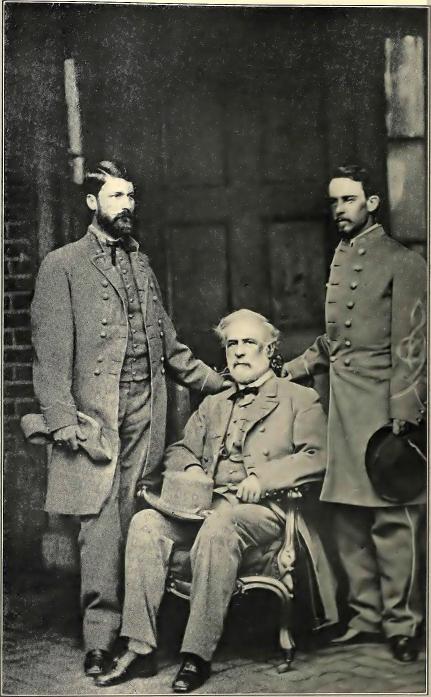 The preponderance of capable military
leaders was an important factor in giving to the Southern armies the
measure of success secured by these armies during the first two years;
but even during this earlier period, military capacity developed also on
the side of the North, and by the middle of the war the balance of
leadership ability may be considered as fairly equal. It may frankly be
admitted, however, that no commander of the North had placed upon him so
stupendous a burden as that which was carried by Lee, as the commander
of the Army of Northern Virginia, through the weary and bloody campaigns
of three years. For the last year of that period, Lee was fighting with
no forces in reserve and with constantly diminishing resources. With
great engineering skill, with ingenuity in utilizing every possible
natural advantage for defense, with initiative and enterprise in turning
defense at most unexpected moments into attack, with a sublime patience
and persistence and with the devotion and magnificent fighting capacity
of the men behind him, Lee accomplished with his Army of Northern
Virginia a larger task in proportion to the resources at his command
than has, I believe, ever been accomplished in modern warfare. The
higher we place the ability of the Southern commander and the fighting
capacity of the men behind him, the larger, of course, becomes the task
of the leaders and armies of the North through whose service the final
campaigns were won and the cause of nationality was maintained. The preponderance of capable military
leaders was an important factor in giving to the Southern armies the
measure of success secured by these armies during the first two years;
but even during this earlier period, military capacity developed also on
the side of the North, and by the middle of the war the balance of
leadership ability may be considered as fairly equal. It may frankly be
admitted, however, that no commander of the North had placed upon him so
stupendous a burden as that which was carried by Lee, as the commander
of the Army of Northern Virginia, through the weary and bloody campaigns
of three years. For the last year of that period, Lee was fighting with
no forces in reserve and with constantly diminishing resources. With
great engineering skill, with ingenuity in utilizing every possible
natural advantage for defense, with initiative and enterprise in turning
defense at most unexpected moments into attack, with a sublime patience
and persistence and with the devotion and magnificent fighting capacity
of the men behind him, Lee accomplished with his Army of Northern
Virginia a larger task in proportion to the resources at his command
than has, I believe, ever been accomplished in modern warfare. The
higher we place the ability of the Southern commander and the fighting
capacity of the men behind him, the larger, of course, becomes the task
of the leaders and armies of the North through whose service the final
campaigns were won and the cause of nationality was maintained.
In going to England in the years
immediately succeeding the war, I used to meet with some sharp criticism
from army men and from others interested in army operations, as to the
time that had been taken by the men of the North to overcome their
opponents and to establish their control over the territory in
rebellion. Such phrases would be used as: "You had twenty-two millions
against nine millions. You must have been able to put two muskets into
the field against every one of your opponents. It was absurd that you
should have allowed yourselves to be successfully withstood for four
years and that you should finally have crushed your plucky and skilful
opponents only through the brute force of numbers." I recall the
difference of judgment given after the British campaigns of South Africa
as to the difficulties of an invading army.
The large armies that were opposed to the
plucky and persistent Boers and the people at home came to have a better
understanding of the nature and extent of the task of securing control
over a wild and well-defended territory, the invaders of which were
fighting many miles from their base and with lines of communication that
were easily cut. By the constant cutting and harassing of the lines of
communication, and a clever disposition of lightly equipped and active
marching troops who were often able to crush in detail outlying or
separated troops of the invaders, a force of some forty thousand Boers
found it possible to keep two hundred thousand well-equipped British
troops at bay for nearly two years. The Englishman now understands that
when an army originally comprising a hundred thousand men has to come
into action at a point some hundred of miles distant from its base, it
is not a hundred thousand muskets that are available, but seventy
thousand or sixty thousand. The other thousands have been used up on the
march or have been left to guard the lines of communication. Without
constantly renewed supplies an army is merely a helpless mass of men.
It is probable, in fact, that the history
of modern warfare gives no example of so complex, extensive, and
difficult a military undertaking as that which was finally brought to a
successful close by the armies of the North, armies which were
contending against some of the best fighting material and the ablest
military leadership that the world has known.
|
![]()
![]()




 The editors have fortunately been able to
include with the great Brady series of army photographs a private
collection, probably unique, of more than four hundred views of the
gunboats on the rivers of the West. Each of these vessels represents a
history of its own. One wishes for the imagination of a Homer which
could present with due effectiveness a new "catalogue of the ships."
The editors have fortunately been able to
include with the great Brady series of army photographs a private
collection, probably unique, of more than four hundred views of the
gunboats on the rivers of the West. Each of these vessels represents a
history of its own. One wishes for the imagination of a Homer which
could present with due effectiveness a new "catalogue of the ships." 

